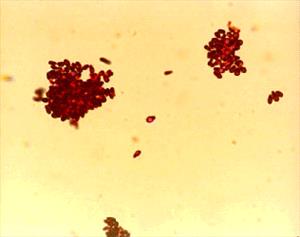
Illustration by Tamara Rees/VIN

The dark footprint-like structures seen here are the yeast organisms: Malassezia pachydermatis.
Photo by CDC.
Yeast infection is the most common type of ear infection in dogs. The yeast organisms are fungi called Malassezia pachydermatis and they are normal on the skin and in the ears. When the ear becomes inflamed and the canal environment changes, the yeast overgrow and create a brown or gray, greasy ear discharge. It is especially itchy and somewhat smelly. It isn’t long before the pet is seen scratching at his ears, shaking his head, or holding one ear slightly dropped. Discharge and odor may be noticeable to the owner.
Yeast overgrowth can have many underlying causes but allergy is particularly common. If the ear infection involves the ear flap or entrance to the ear canal rather than the canal itself, this is a hint that allergy is at the root of the problem. In these patients, ear infections are often recurrent and accompanied by other skin disease. Regular ear washes at home are frequently needed to disinfect the ear and control the recurrent inflammation.
Some primary, or underlying, causes of ear infection include allergies (atopic dermatitis or food hypersensitivity) and narrowed ear canals. Studies have shown that bacteria can be found in combination with a Malassezia otitis.
Treatment
Level One: The Simple Ear Infections
Most ear infections are cleared up simply with professional cleaning followed by medication at home. If only mild debris is present in the ear canals, simple disinfection and washing of the ear is adequate; however, in many cases, a full ear flush is needed to even examine the eardrum. For patient comfort, we recommend sedation for this procedure as the ears are sore and the instruments can be damaging if the pet jumps at the wrong time. A sample of ear discharge is commonly examined under the microscope so as to assist in selecting medications for home use. After a couple of weeks of home treatment, the ear canals are rechecked to be sure the infection is gone. In most cases this completes treatment but for stubborn cases, we must proceed to the next step.
Level Two: On-Going Ear Infections
Some dogs have chronic ear problems (the infection is not controlled by general medication or returns when general medication is discontinued). In these cases, the ear discharge should be cultured so that the precise organism can be pinpointed and treated specifically. Regular treatment at home with disinfecting ear washes should become part of the pet's grooming routine.
Further testing may be in order to determine why the infection continues to recur. Allergy is the most common reason for recurrent ear problems but hormone imbalances can also be underlying causes.
Level Three: The End-Stage Ear
Some ear infections simply cannot be controlled with the above steps. These cases have transcended medical management and must proceed to surgical management. What this entails will depend on the state of the ear canal. Your veterinarian will make recommendations accordingly.
Ear infections are common and can be challenging. Fortunately, most cases are simple and easily cleared up. Be sure to recheck the ears as your veterinarian recommends because ending treatment early can lead to a continuing infection.
Complications of Yeast Ear Infection
Aural Hematoma
When a dog with uncomfortable ears shakes and scratches vigorously, a blood vessel in the earflap may rupture. This leads to bleeding into the tissues of the pinna (ear flap). The usual recommendation is to have the blood clots removed and the ear bandaged and cleaned under anesthesia. If the hematoma is not so big as to occlude the ear canal (thus preventing medication of the ear canal), the option to forgo surgery exists; but without surgery, the ear may scar down into an abnormal appearance.
Proliferative Ear Canal Change and Middle Ear Infection
A routine ear infection is uncomfortable enough but if the infection persists, it can become an even bigger problem. The infection can lead to proliferation and scarring in the canal which makes the infection especially difficult (and potentially impossible) to clear up. Yeast organisms are joined by resistant bacteria and the infection becomes even more difficult to address.
The ear canal may mineralize and the middle ear may come to be involved, leading to nerve damage. Affected animals may have a head tilt, a lack of balance, and unusual back-and-forth eye movements (called “nystagmus.”) These symptoms are called vestibular signs”and are a complication of middle ear infection. Middle ear infections can also cause paralysis of the facial nerve, leading to a slack-jawed appearance on that side of the face.
Severe cases may require surgical intervention to remove the vertical portion of the ear canal (lateral ear resection) or even remove and seal the ear canal (ear canal ablation). It is important to control ear infections before they reach this stage if at all possible.